Micron surges after one of the biggest beats in U.S. semis history
Last week, as traders were all on vacation, the market surged to 2600 as the “inmates ran the asylum.” The expectation of a better than anticipated shopping holiday season and ongoing hopes of “tax cuts and reform” lifted stocks higher. The current advance, is still working the general year-end pattern I laid out three weeks ago as shown below.
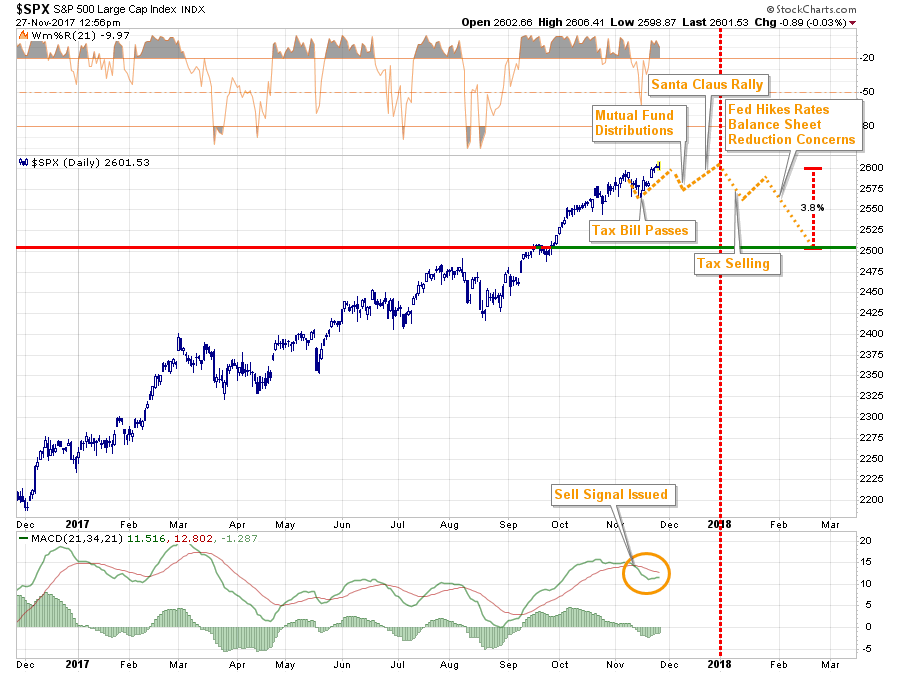
With earnings season nearing its conclusion, the markets will begin to focus more heavily on the economic data which has been weak as of late.
Furthermore, with the Fed continuing to hike rates, and professional investors waiting to take gains until January, the risk of a Q1 sell-off has risen markedly in recent weeks. This is particularly the case given the short-term deviation from longer-term trends in the market.
The chart below shows the percentage deviation above the 3-year monthly moving average. Previous deviations have resulted in an eventual reversion to, or beyond, the 3-year moving average. A reversion to the monthly moving average currently would entail a -15.8% decline. While such a decline would not register as a “bear market,” which would require a 20% decline, given the record length of time without so much as a 3% correction, such a decline will certainly “feel” like a bear market.
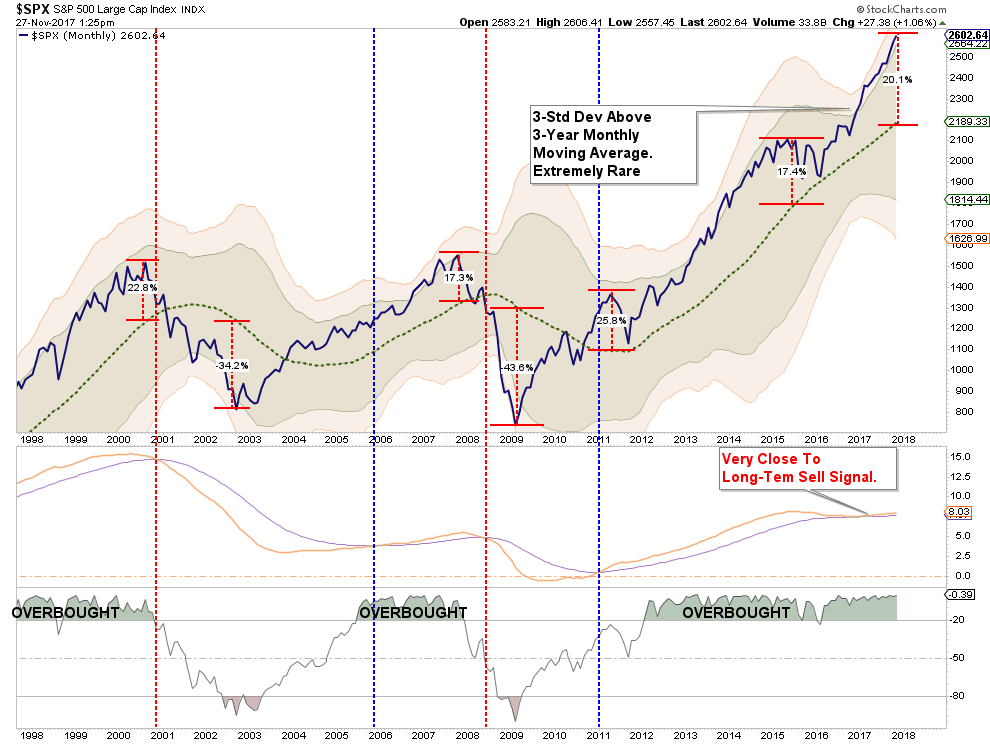
A correction back to the moving average would not require an “earth-shattering” event. A recognition of the Fed continuing to tighten monetary policy into a weak economic cycle, a “buy the rumor/sell the news” mentality around the tax reform plan, a failure to pass tax reform, or a litany of other unanticipated events could send markets lower. Importantly, a correction of that magnitude would NOT change the longer-term bullish trend of the market.
While our portfolios remain allocated towards equity risks currently, we remain keenly of aware of the risks we are currently undertaking.
The reason I focus so much on managing risk is because trying to predict anything about the market is nothing more than a “guess.”
Predicting The Future Is Difficult
Neils Bohr, a Nobel prize-winning Danish physicist who made foundational contributions to the understanding of atomic structure and quantum theory, is credited to have once said:
“Prediction is very difficult, especially if it’s about the future.”
While it sounds more like a “Yogi-ism,” the point made is interesting particularly as it relates to investing.
I really don’t care much for the “bull/bear” debate that ensues on a daily basis as both camps are eventually wrong. When investing in the markets “it is, what it is” and it is of very little use that some pundit or analyst was “right” during the bull market if they never saw the bear market coming.
The opposite is also true.
Predictions of the future are indeed very difficult, and yet individuals are challenged every day with doing precisely that. For traders, it is what the market, or a particular investment, will do in the next few minutes to days. For longer-term investors, those predictions move out to months or years.
The problem is that humans generally suck at predicting the future, particularly when it comes to investing. This is clearly shown in Dalbar’s 2017 investor study in what they term the “Guess Right Ratio.” To wit:
“DALBAR continues to analyze the investor’s market timing successes and failures through their purchases and sales. This form of analysis, known as the Guess Right Ratio, examines fund inflows and outflows to determine how often investors correctly anticipate the direction of the market. Investors guess right when a net inflow is followed by a market gain, or a net outflow is followed by a decline. Unfortunately for the average mutual fund investor, they gained nothing from their prognostications.”

The inability of investors to correctly predict the future has had serious consequences for their portfolio both in the short and long term as shown in the two tables below.
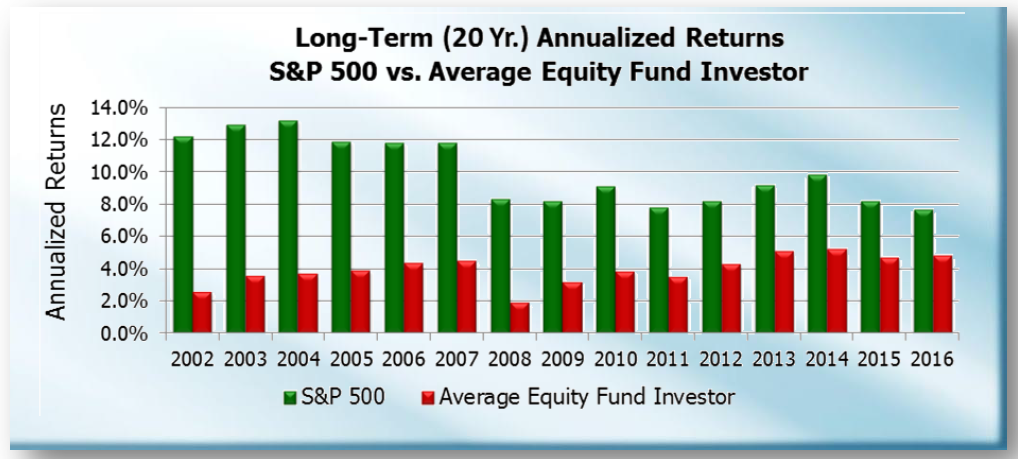

The massive underperformance over a 30-year span shows that investors, despite the best of intentions of being “long-term” are saddled not only by poor predictions of the future, but also the “emotional biases” that drive accumulations and liquidations at the most inopportune times more commonly known as the “buy high/sell low” syndrome.
Currently, it is “predicted” that the market will only rise from currently record levels as witnessed by a recent report from Goldman Sachs:
“Rational exuberance” best describes our forecast for the trajectory of the S&P 500 during the next several years. Earnings drive stocks over time and should support the index rising to 2850 at year-end 2018, 3000 at the end of 2019, and 3100 by the close of 2020, representing a price gain during the next three years of 20% (see Exhibit 1). Our price targets imply a modest expansion in forward P/E multiple to 18.2x at year-end 2018, a flat multiple in 2019, and a contraction to 18.1x in 2020.”
However, Goldman, like all humans, including me, are horrible predictors of future outcomes. As an example this is what Abby Joseph Cohen predicted in 1999 at the height of the “Dot.com” bubble:
“The S&P 500 is ending 1999 at roughly fair value, in contrast to the investing undervaluation of prior years. This suggests that price appreciation will be closer to historical trends, as will volatility.”
At that time, Cohen predicted the S&P 500 index will hit 1,525 by the end of 2000.
Unfortunately, for investors, the S&P 500 ended 2000 near 1300 on its way to 800.58 by the end of 2002.
Like all economists and analysts using data to make future predictions, that data is highly subject to revisions in the future. This is the equivalent of trying to shoot a moving target while blindfolded riding a merry-go-round. While I am sure there is some trick shot artist that could nail such a feat on “America’s Got Talent,” for the mere mortal the odds of success are extremely low.
The same problem that exists for individuals also applies to “professionals.” There are but a handful of investment managers that have consistently outperformed the “market” over long periods of time. But even that comment is a bit misleading as relative outperformance is of little consolation to investors when the market is down 30%, and the portfolio is down 29%.
Did the manager outperform? Yes.
Did the investor stick around? Probably not.
But it is precisely this conversation that leads to a litany of articles promoting “buy and hold” investing. While “buy and hold” investing will indeed work over extremely long periods, investor success is primarily a function time frames and valuation at the beginning of the period. Considering that most investors have about a 20-year time horizon until the reach retirement, the “when” becomes a critical component of future success.
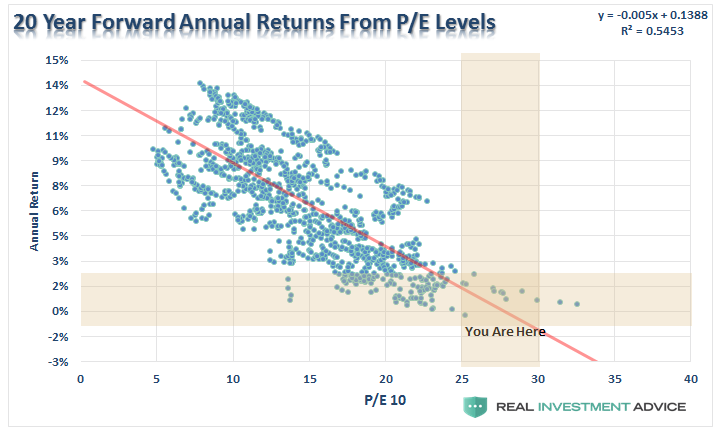
Of course, “buy and hold” commentary is mostly seen near fully mature “bull markets” as the previous bear market fades into distant memory. Eventually, despite the best of intentions, the markets will complete their full-market cycle and investors will head for the exits perpetuating the “buy high/sell low” syndrome.
It is here that we find the VERY BEST predictor of future outcomes – past behavior.
Psychology Today had a very interesting piece on this particular issue as it relates to violent crimes. But when it comes to investing, most individuals fit the requirements necessary to fulfill how they will behave in the future.
- Habitual behavior – (buy high/sell low)
- Short time intervals – (months or years, not decades)
- Anticipated situation aligns with the past situation that activated behavior. (bull vs bear market)
- Behavior not extinguished by negative impact. (loss not great enough to deter future action)
- Person remains essentially unchanged. (speculator vs saver)
- Person is fairly consistent (willingness to accept risk/avoid loss)
Certainly, past behavior may not accurately predict the future behavior of a single individual. However, when it comes to the financial markets which is representative of the “herd mentality,” past behaviors are likely good indicators of future outcomes.
Despite an ongoing litany of bullishly biased reports as markets push towards new highs, it should be remembered that markets only attain new highs about 5% of the time historically speaking. The other 95% of the time is recouping previous losses.
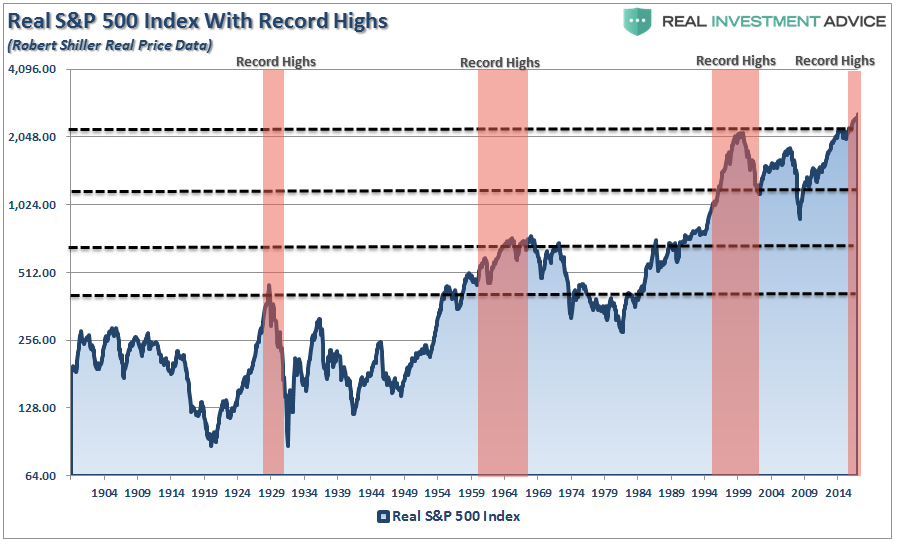
Does this mean that you should sell everything and go to “cash?” Of course not. However, it does mean that as an investor you should critically analyze your past personal behavior during market advances AND declines.
If you are like MOST investors, it is likely that in the past you did exactly the opposite of what you should have. If that is the case, does it not make some sense to begin thinking about doing something different?
